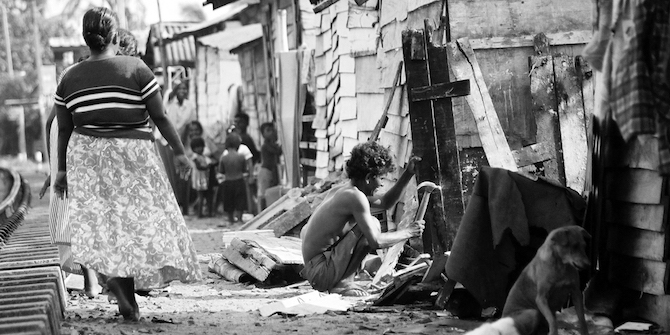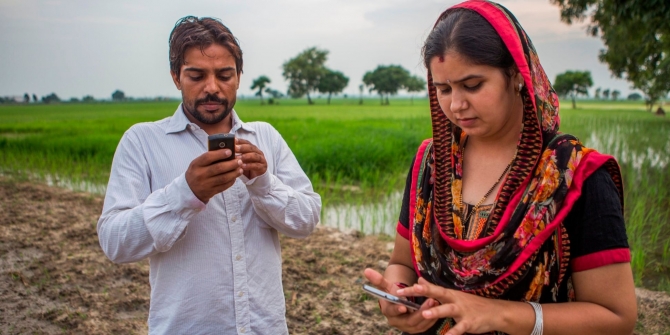 The benefits of the China-Pakistan Economic Corridor have been widely celebrated by Pakistan’s politicians and media alike but the reality is there is very little information about the details available. Asad Abbasi argues that even if the Chinese investment delivers the growth Pakistan is hoping for, inequality will rise unchecked unless redistributive reforms are introduced.
The benefits of the China-Pakistan Economic Corridor have been widely celebrated by Pakistan’s politicians and media alike but the reality is there is very little information about the details available. Asad Abbasi argues that even if the Chinese investment delivers the growth Pakistan is hoping for, inequality will rise unchecked unless redistributive reforms are introduced.
What is CPEC?
With One Road One Belt, an ambitious £900 billion initiative, China aims to connect with Africa, the Middle East, Central Asia, and Europe via sea route and overland corridors. The China-Pakistan Economic Corridor (CPEC) is the pilot project of this grand scheme. CPEC brings $62 billion in investment and loans for Pakistani infrastructure, the energy sector and the development of Gwadar Port. The road network that connects Gwadar Port in southwestern Baluchistan to Xinjiang, the far western part of China, reduces overland transportation from twelve days to thirty-six hours.
Why is CPEC interesting?
For the first time, political parties in Pakistan stand united. They stand united in welcoming China’s precious ‘gift’ of CPEC. The benefits of CPEC linger in the political speeches, academic seminars and the precocious media. Rarely a day passes by without a positive spin on CPEC. Thus, the majority of analysis compares CPEC to a golden goose which requires the patience, acumen, and desire of politicians in order to ‘reap rewards’. Yet, there is hardly any evidence to support this unanimous optimism.

In terms of information, we know very little. Finally, after two years of mostly euphoric reports, one newspaper got hold of the CPEC ‘Master Plan’. Astonishingly, the report claims that China eyes Pakistani agriculture more than anything else. Ahsan Iqbal, Minister of Planning, Development and Reform, condemned the publication of the document, which he claims to be a ‘live document’ that could be modified ‘periodically’. But details about interest rates on the loans, and what percentage of funds will be loans and what would be FDI remains, as of yet, an accounting mystery.
Why such support?
The reason for optimism is simple. It allows the political establishment to avoid taking the difficult choice of taxing itself. Foreign loans and aid — which according to Jan Breman, respected expert on South Asia, arrive ‘thanks to the geopolitical considerations of the United States’— form an important feature of Pakistani economics. This is no secret. In fact, Ayub Khan, Former Chief of Army Staff and second President of Pakistan, understood that elites won’t pay taxes and therefore ‘external assistance’ should be sought. From 1951 to 2011, the United States paid about $67 billion dollars, mostly for security assistance. As the geopolitical ‘considerations’ from the serial donor, the United States, lessen, so do the funds. The Pakistani establishment recognises two separate choices: revert to asking for ‘external assistance’ or initiate redistributional reforms through proper taxation. The optimism surrounding CPEC ticks the first option.
What do you see as the consequence of CPEC?
In absence of data, details, and deals, it is difficult to talk about consequences. However, if we permit several assumptions about the project, we could point, in simple terms, to the extremes: At its worst, CPEC puts the Pakistani economy in debt bondage; at its best, CPEC brings economic growth.
Aren’t politicians saying the same thing: CPEC will bring growth?
Yes. The politicians promise era of unhindered economic growth.
You say as if you don’t agree. Isn’t growth good for everyone?
Growth is not neutral, it discriminates. Growth favours the rich, the educated, the resourceful and ignores the poor and the vulnerable. Despite two decades of ‘unprecedented growth rates’ in Africa, mainly due to Chinese investment, the standard of living barely rose for millions of people. In fact, the income per capita increased only ten percent compared to income in 1980s. Pakistan, according to William Easterly, experienced ‘respectable’ growth rates between the 1950s to the 1990s. Yet, this economic growth failed to translate into ‘social and institutional progress’.
More for the rich but some for the poor. Right?
Not necessarily. The above statement makes a ‘trickle down economics’ assumption, which states the benefits that rich enjoy will transfer/trickle down to the whole society. One problem: This assumption does not work in the real world.
The way to spread resources is to construct redistributive programs such as free education, health care, subsidies and other utilities. To fund these programs, states impose concrete tax policies. According to the IMF, the Pakistani economy loses about $33 billion dollars annually due to misreporting and underreporting. If that is the case, the sum total of CPEC money could be collected, without loaning sovereignty, within three years. But that requires the establishment to tax itself.
What are the consequences if redistributive reforms are not introduced?
Let’s assume CPEC is an economic success. This means that the project generates trade and increases economic growth. We understand that growth favours the rich so all benefits will be accrued at the top. In absence of redistributive reforms, we can conclude that income inequality will rise. This is not a theoretical conclusion. South Africa is a prime example.
Since 1994, the South African economy registered positive growth in every quarter (bar two), but without institutional redistribution we see unparalleled rise in inequality. The Gini coefficient in South Africa is one of highest in the world. According to Thomas Piketty, respected scholar, inequality in present-day South Africa surpasses income inequality during the Apartheid era.
Why be concerned about income inequality?
Apart from the moral questions of unfairness, inequality threatens the political structure of a society. The rich, according to 18th century philosopher, Jean Rousseau, control the laws, the people, and continue to exploit the vulnerable. For such reasons, Aristotle conjectured that democracy and inequality cannot co-exist. One will get rid of the other.
How can we stop high inequality then?
Taxation is the solution.
But isn’t taxation avoided by the establishment in the first place?
Precisely. Now you see the cyclical problem. The tax reform, that elites expect to avoid, is the policy that takes the benefits of growth away from the few to the many.
Pakistani elites are not the only ones trying to avoid taxes. It happens everywhere. Tax-to-GDP ratio in Pakistan is about ten percent. In the first decade of twentieth century, France, Germany, and the United States had a similar tax-to-GDP ratio. These statistics changed in the wake of the First and Second World Wars. The elites were forced to pay higher taxes. ‘In the wake of these shocks’, Thomas Piketty suggests, ‘western elites finally gave in to the kind of social and tax reforms that they had denied prior 1914.’
In Pakistan, however, ‘external assistance’ could always be relied upon. So much so that not only the establishment is against tax reforms, but industries involved in CPEC also benefit from tax exemptions in the so-called Special Economic Zones. Not only that, but projects like the Orange Metro line in Lahore, that bear no direct links with CPEC, apparently qualify for tax exemption. This shows elites’ aversion to taxation. As long as tax reforms do not rise in the national conversation, CPEC promises to benefit only the few and not the many.
So, what is CPEC again?
CPEC is a tool, an ‘external assistance’ that helps the establishment delay tax reforms once again. Until the Pakistani state initiates proper tax reforms, CPEC may increase economic growth but also raise income inequality, which harms, let’s say, ‘99 percent’ of the population.
This post originally appeared on IAPS Dialogue with the title A Conversation About CPEC. It is cross-posted with permission.
This article gives the views of the author, and not the position of the South Asia @ LSE blog, nor of the London School of Economics. Please read our comments policy before posting.
About the Author
 Asad Abbasi has a Masters degree in Political Economy of Late Development from LSE. Currently, he is researching conceptual frameworks of development.
Asad Abbasi has a Masters degree in Political Economy of Late Development from LSE. Currently, he is researching conceptual frameworks of development.








Hi, Is there a way to reach out to the author ? Thanks!